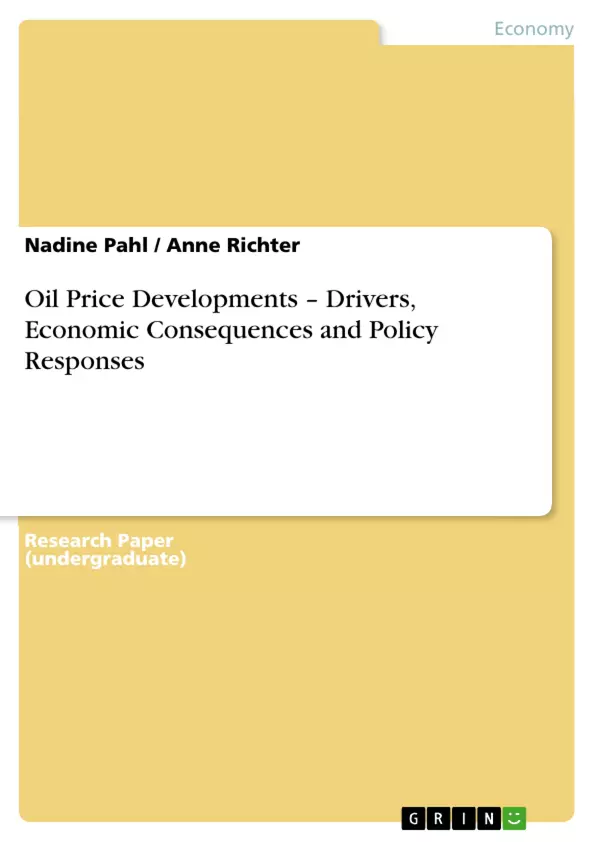Oil prices are an important determinant of global economic performance. Crude Oil prices ranged between $2.50/bbl and $3.00/bbl from 1948 through the end of the 1960s. As of this day, the price for crude oil is $89.82/bbl. In general, spikes in oil prices are not unusual and are, to some extent, symptomatic of a gradual upward trend in daily oil price volatility. Volatile prices arise from supply and demand that are both highly inelastic in the short run, with the result that even small shocks can have large effects on price. But especially within the last few years, the oil price has continuously increased sharply – and to some extent unexpected. This recent sharp increase in the oil price prompts several questions: Why have oil prices risen? What is the impact on the global economy and on individual countries? How do oil importing countries cope with the higher prices? What are appropriate policy responses to stabilise the economy in face of high oil prices? And last but not least, what role does the Organisation of Petroleum Exporting Countries really play? To begin with, there is no doubt that the recent increase in oil price is mainly demand driven, combined with historically low excess capacity and heightened concerns about supply disruptions. And even without macroeconomic knowledge, everyone is aware that higher oil prices affect the economy as a whole and all its market participants. In the following, this paper analyses in detail the current main oil price drivers, their economic consequences and the possible policy responses - always framed by the volatility and uncertainty that characterise the oil market.
Inhaltsverzeichnis (Table of Contents)
- Overview
- Introduction
- Oil as a Non-Renewable Resource
- Suppliers of Oil
- Oil Price Developments from Past to Future
- Drivers of current High Oil Prices
- Strong World Economic Growth
- Supply Decisions of OPEC and Non-OPEC
- Role of Inventory Standards
- Distributional Bottlenecks
- Geopolitical Tensions and Natural Disasters
- The Role of Commodity Trading
- Scarcity of Oil Resources as Long-Term Driver
- Economic Effects of High Oil Prices
- Impact on Global Economy
- Change in World GDP
- Risk of Rising Inflation
- Financial Markets
- Quantifying the Impact of Higher Oil Prices on Oil Importing Countries
- Economic Impact on Advanced Economies
- Economic Impact on Emerging Markets and Developing Countries
- Possible Policy Responses to Higher Oil Prices
- The Role of Policy Responses
- Monetary Policy
- Fiscal Policy
- Structural Policy
Zielsetzung und Themenschwerpunkte (Objectives and Key Themes)
This assignment analyzes oil price developments, exploring the factors driving price fluctuations and their economic consequences. It also examines potential policy responses to high oil prices. * Analysis of factors influencing oil prices. * Assessment of the economic impact of high oil prices on various economies. * Evaluation of potential policy responses to mitigate the effects of high oil prices. * Examination of the role of OPEC and non-OPEC producers in shaping oil prices. * Exploration of the long-term implications of oil scarcity.Zusammenfassung der Kapitel (Chapter Summaries)
The initial chapters provide an overview of oil as a non-renewable resource, examining its suppliers and historical price trends. Subsequent chapters delve into the key drivers of high oil prices, including economic growth, OPEC and non-OPEC supply decisions, inventory levels, distribution issues, geopolitical factors, and commodity trading. The economic consequences of high oil prices are then discussed, focusing on impacts on global GDP, inflation, and financial markets, with separate analyses for advanced and developing economies.Schlüsselwörter (Keywords)
Oil prices, economic growth, OPEC, non-OPEC, supply and demand, inflation, economic impact, policy responses, geopolitical risks, commodity trading, scarcity, global economy, developing economies, advanced economies.- Citar trabajo
- Nadine Pahl (Autor), Anne Richter (Autor), 2007, Oil Price Developments – Drivers, Economic Consequences and Policy Responses, Múnich, GRIN Verlag, https://www.grin.com/document/124555



